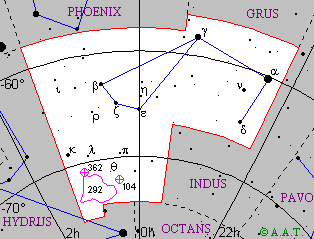 |
 |
| English name | Toucan | ||||
|---|---|---|---|---|---|
| Major stars | alpha Tucanae | magn. 2,9 | RA: 22h 18m 30.21s | Dec: -60° 15' 34.4" | |
| Description | Constellation to the southwest of Achernar, the principal star of Eridanus. Even though it is not very bright, nevertheless it contains at least three considerable objects: two globular clusters and the Small Magellanic Cloud. They all are situated in the southern zone of the constellation, near the border with Hydrus. The first globular cluster, NGC 104, is among the most beautiful clusters of the whole vault of heaven: to the naked eye it seems an out-of-focus spot of fifth magnitude, but a small instrument put in evidence the increase of brightness toward the center. And if you use a little more powerful telescope, you succeed in isolating a lot of the more than one hundred thousand stars which compose the cluster. NGC 104 is about 20.000 light-years away from us. The second globular cluster is NGC 362, of sixth magnitude, easily visible with binoculars. It is approximately 40.000 light-years away.
|
||||
| Mythology and history | The constellation was drawn by the Dutch navigators Pieters Dirkszoon Keyser and Frederik de Houtman towards the end of the XVI century. It represents the bird of which it has the name. | ||||
 Back to constellations page.
Back to constellations page.